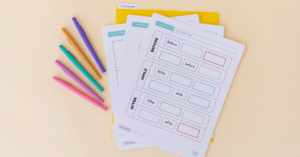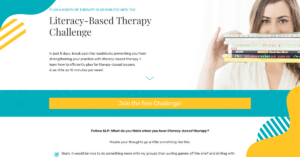Listen on Apple Podcasts Listen on Spotify
What keeps an SLP from becoming a tutor? This framework. 👇
Okay, that’s not totally true — using a framework is not the only thing that distinguishes a tutor from an SLP! But it can definitely help, and that’s what we’re talking about in this week’s episode of the SLP Now Podcast:
Literacy-Based Therapy Bootcamp: How to Choose a Book
We want to be really clear that being a tutor is amazing, and being an SLP is amazing. This is not a conversation about one profession being better than another, it’s about understanding the role each person plays in helping a student succeed.
A tutor’s job is to help students learn the material from the curriculum and keep up in the classroom.
As an SLP, our job is to focus on the language underpinnings: phonology, morphology, syntax, semantics, and pragmatics
That’s what we do best, and it’s how we help our students build the skills and strategies that they need to be successful beyond the classroom.
Literacy-based therapy offers a great framework to support the development of language underpinnings, and at SLP Now, we like to talk about one that was developed by Dr. Ukrainetz. Her framework for literacy-based therapy includes five steps:
1️⃣ Pre-story knowledge activation
2️⃣ Read
3️⃣ Post-story comprehension
4️⃣ Focused skill activities
5️⃣ Parallel story
Using this framework, you can target almost any goal — but it’s really important to be strategic when you’re selecting a text. (Especially if you want to create a whole month of therapy plans using just one book!)
If there’s language involved, we can make it happen. 💪
Episode Summary
In this episode, Marisha talks about:
✅ Criteria to select texts that can be used in a functional and therapeutic way
✅ The best length of book to use
✅ What happened when she didn’t follow these criteria
✅ Targeting multiple goals with one book
✅ When to use an expository text versus narrative structure
✅ What to do if the text you’ve selected doesn’t have appropriate targets
✅ Aligning texts with the curriculum
Links + Resources Mentioned
Join our free Literacy-Based Therapy Challenge After you’ve joined, keep an eye out for an email from us and don’t forget to download your workbook! 📕
Subscribe
Subscribe to the SLP Now podcast and stay tuned for our next series. We’re kicking off September by helping you get your data collection, paperwork, and therapy planning processes in tip-top shape! 💪
Listen to The SLP Now Podcast on Apple ★ Spotify ★ Google ★ Stitcher ★ Castbox or wherever you listen to podcasts.
Transcript
Speaker 1:
Hello there, and welcome to the SLP Now Podcast, where we share practical therapy tips and ideas for busy speech-language pathologists. Wrap your favorite beverage and sit back as we dive into this week's episode.
Hey there, I am really excited for this next series of podcast episodes. We are going to be doing a literacy-based therapy challenge. This is the challenge that we've had thousands of speech-language pathologists run through with us. And the goal of the challenge is to help you, either if you're new to literacy-based therapy, come up with a nice easy system and boost your confidence when using literacy in your therapy sessions. And then for SLPs who are already using books and articles, and using some literacy-based therapy strategies, this is a really great way to step up what you're doing and streamline and, again, boost your confidence. So to access the resources, I've created a really beautiful workbook that goes along with this challenge. So if you went to head to slpnow.com/challenge, you'll be able to just pop in your email and we'll send you the workbook so you can follow along with the challenge as we go through.
So that's your first action step. Go ahead and hit pause, go to slpnow.com/challenge and download that workbook. And then before we dive into selecting a book to use and going through the five steps of the literacy-based therapy framework, this challenge is much more helpful when you are able to work with a specific group. It just makes it that much more concrete and actionable. So I suggest that you think of one group that you would like to try this with. So jot down the name of the group or just keep it in your head, which group are you wanting to practice this with, then we'll also talk through selecting a text. And if you need some inspiration and you're not sure which book you'd like to use, just send us a DM on Instagram, message us on Instagram, and we'd love to help you with that step. And if you have any questions along the way, please don't hesitate to reach out. Instagram is a great way to do that. Or you can email us at hello@slpnow.com. And without further ado, let's dive into the challenge.
Okay, let's do this. We officially get to get started with day one of the literacy-based therapy challenge. So I've got my workbook printed and ready to go. And our goal for today, hopefully yesterday we picked a group, so if you haven't picked your group yet, open up to this page in the workbook day zero where you just pick your group, write down their goals. That'll be super important. And the next thing that we want to do is to select a text. We are going to pick a book to use for our literacy-based therapy unit. And so I gave you some suggestions in the workbook if you want to check those out, but I wanted to chat about some quick criteria for selecting a book. So the whole framework that we're talking about was developed by Dr. Ukrainetz, and she has a fabulous textbook that breaks down that approach and gives us tons and tons of practical tips and resources.
But one thing that she talks about is selecting a book and being strategic in how we select that book. So she talks about three main criteria that allow us to select texts that we can use in a very functional and therapeutic way. And she talks a lot about her framework to help us be therapeutic instead of tutors. So these criteria, if we're selecting texts in this way, we can select essentially any text and make it work for our students, and we can use a text to target virtually any goal. If there's language involved, we can make it happen and we'll share lots and lots of ideas on how to do that throughout the week. But the three criteria are, one, select a text that can be read in 10 minutes or less.
So when I was starting with literacy-based therapy, I got a little bit ambitious and I selected some chapter books for my older students and I was like, "Yes, this is going to be amazing, we're going to keep up with the classroom, and then with this grade I'm going to help them read their social studies textbook. It's going to be fabulous." But it ended up not being so fabulous. I was turning into a tutor because I was trying so hard to keep up with what they were doing in the classroom. And I found that picking smaller subset of texts, so something that can be read in 10 minutes or less, was much more effective. It let me implement the framework that we'll be diving into this week, and it allowed me to slow things down and really focus on the language underpinnings. That's what our job is. We are helping our students build the skills and strategies that they need to be successful because we aren't going to follow them around forever, even though we would love to do that with some of our students, but we really ultimately want them to be independent.
So that's criteria one, select a text that can be read in 10 minutes or less. The second strategy, or the second tip, is to find a text that has multiple demonstrations of targets. And I feel like we can make a text work with pretty much any goal. Of course, if there's something really specific that we want to target, like if we're targeting summarizing, we probably want to have a text that is an expository text. Or if we really want to target story grammar, we probably want to select a fiction text, but beyond the overarching categories, there's very few exceptions. If I really want to target past tense verbs, even if the book is written in present tense, that still gives me the opportunity. It has verbs in it, so I can still set up some contrastive imitation and use that evidence back strategy even if those past tense verbs aren't directly written in the text.
Or if I really want to target some specific prefixes or suffixes, even if it doesn't have those specific prefixes or in the text, we can create sentences using those words and apply them to the text, but it does help a little bit. So I have gone through and analyzed hundreds of books, and quite a few non-fiction and fiction articles as well, and pulled out their targets. One example is irregular plural nouns. There aren't that many of them. And if a student has a goal to work on irregular plural nouns, I would really like to see them in context. So that's something that I'll look through my book guide to see and to find those targets.
And then the third criteria that Dr. Ukrainetz recommends is that the text aligns with the curriculum. We can simply align the topic to what they're discussing in the classroom, or we can pull from something directly that they're actually using in the classroom. And we'll dive into that a little bit more later. I would recommend just focusing on those first two criteria. You've got your students' goals, pick something that will allow you to target those goals, and select something that's not too long. And if you've got that, you'll be good to go and will learn more along the way.
Thanks for listening to the SLP Now Podcast. If you enjoyed this episode, please share with your SLP friends, and don't forget to subscribe to the podcast to get the latest episodes sent directly to you. See you next time.
Sign up to receive email updates
Enter your name and email address below and I'll send you periodic updates about the podcast.




Reader Interactions